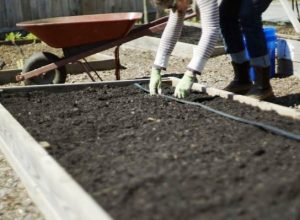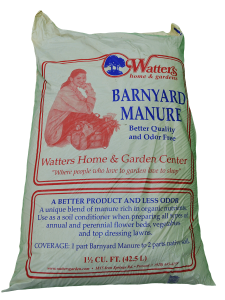By Ken Lain, the mountain gardener
Once you’ve tried digging the first planting hole in a mountain garden you learn that our native soils are HARD
January is my month to amend garden beds, turn the soil, and let the garden rest before a March 1st planting. Here are a few secrets to mountain soil prep that return bushels of produce and a season full of flowers. Any successful backyard garden, whether in the ground or in raised beds, requires these easy steps.

The more organic material any soil contains, the better the quality of that soil. Our mountain soils are hard because they lack organics such as compost, manures, and leaf molds. Because plants use up organic resources throughout the year, new organics must be added regularly to keep the vitality of the soil alive.
A word of caution for those gardeners new to horse country. You are apt to see a sign in a front yard advertising “Free Manure”. Proceed with caution before you haul away this free organic additive and turn it into your garden soils. Horse manure is a great source of organic nitrogen, but not until it has aged. Never introduce fresh manure into your garden. The salt and nitrogen damage is unpredictably destructive.
Whatever goes into a horse’s mouth comes out the other end. That includes weeds as well as barley, alfalfa, straw, and hay. Also, huge white grubs find their way into the warmth of a huge pile of manure. The only way to get fresh manure suitable for gardening without the weeds and bugs is to age it, also known as composting. You must compost, then check there are no large white bugs eating at the middle of the pile. If this scenario isn’t for you, fear not. You don’t have to deal with fresh manure to enjoy the pleasures of a successful garden.
For my smaller garden plots I used deodorized ‘Barnyard Manure’ that comes bagged and ready to add to the garden. This aged poop has a mixture of manure types, it doesn’t smell, and it isn’t slimy. This year my gardens again received a generous dose of 50% Watters Barnyard Manure and 50% of Watters Premium Mulch.
The mulch and manure additives ensure proper drainage, root growth, and water retention for successful garden growth. But, certain mountain plants require calcium, magnesium, phosphorus, and some other minor elements, all of which should be added to a garden’s soil.

Before turning the compost additives into the planting bed, add two sources of nutrition. The first is a layer of gypsum, also known as calcium sulfate, the most effective source of calcium for plants. The second is an organic plant food I created called ‘All Purpose Plant Food‘ 7-4-4. In flowerbeds it works to produce amazing color and fragrance!
Soil pH creeps up during the growing season. This is a problem that results from poor water and one that must be corrected to keep plants in the ideal 6.5 – 7.5 pH range. When your garden pH rises above 8.0 production stops, fruit drops, the plants yellow, wilt, and finally drop their leaves. Granular Soil Sulfur turned into your garden soil to one shovel’s depth is the correction to bad garden pH, and every mountain garden needs it.
In summary, here is the formula of soil amendments and additives to use this spring: Begin with a 2-inch layer of 50% ‘Premium Mulch’ and 50% ‘Watters Barnyard Manure’. On top of this organic layer sprinkle the recommended rates of gypsum, All Purpose Plant Food 7-4-4, and Soil Sulfur. Turn these to one shovel’s depth into your garden soil and you are ready to plant.
Freshly turned soil is light and airy, so tread carefully on your amended garden soil so it retains this texture. Walk on predefined paths or use a wood plank to walk over the soil without compacting it unnecessarily. We should have at least two good winter storms before March first, but if we don’t, deeply water your garden soil two times before planting. This will reduce damage if too much manure was added or if it congregated unevenly into the soil.
Exact additive amounts were not given in this column because those depend on the size of your garden plot. So talk to someone on Watters’ staff for exact quantities of each additive to purchase, remembering to bring along your garden measurements.
Coffee Grounds are often mentioned as soil amenders, Learn More from our recent Post
“ Using Coffee Grounds as Fertilizer”
Free Gardening Class January 19 @ 9:30am ~ Happy Healthy Houseplants
We believe plants make people happier, and not just outside of our homes, but indoors, too! Houseplants brighten our homes and our lives, and even clean the air we breathe. However, not all houseplants are created equal when growing in an arid climate like ours. You’ll get a list of the top houseplants best grown indoors and how to care for them. Learn best practices for watering, light placement, and how to treat and prevent pests and diseases that can affect your indoor garden. As usual, class meets at Watters Garden Center.
Until next issue, I’ll be helping gardeners here at Watters Garden Center.
Ken Lain can be found throughout the week at Watters Garden Center, 1815 W. Iron Springs Rd in Prescott, or contacted through his web site at WattersGardenCenter.com or FB.com/WattersGardenCenter .


